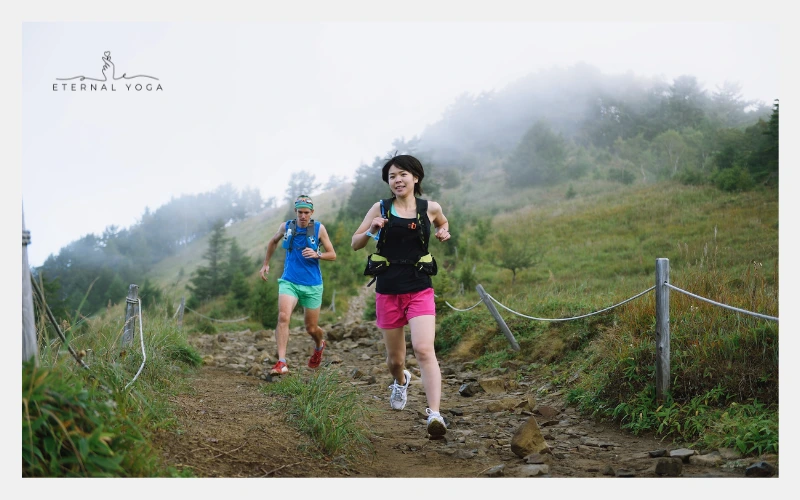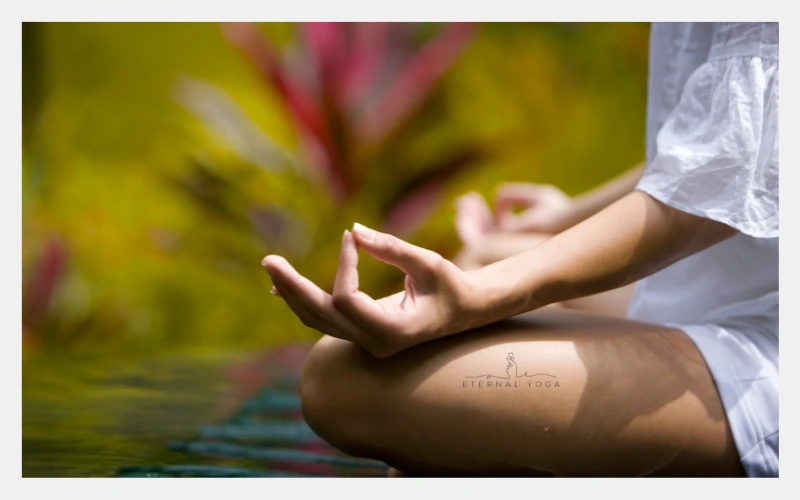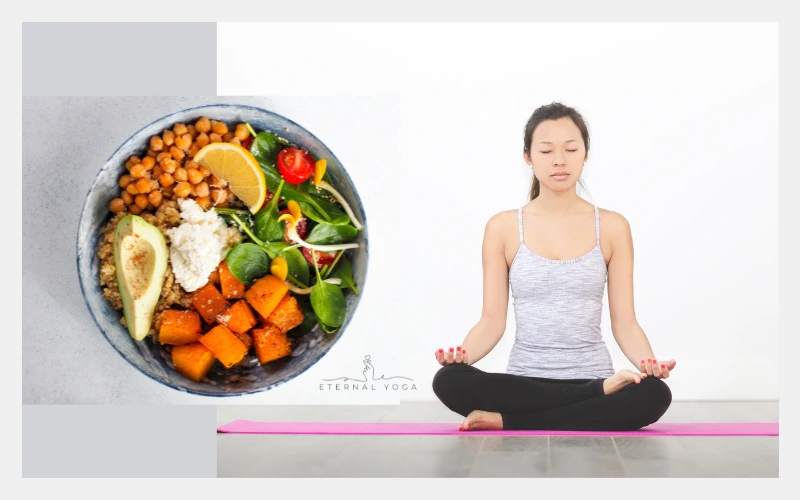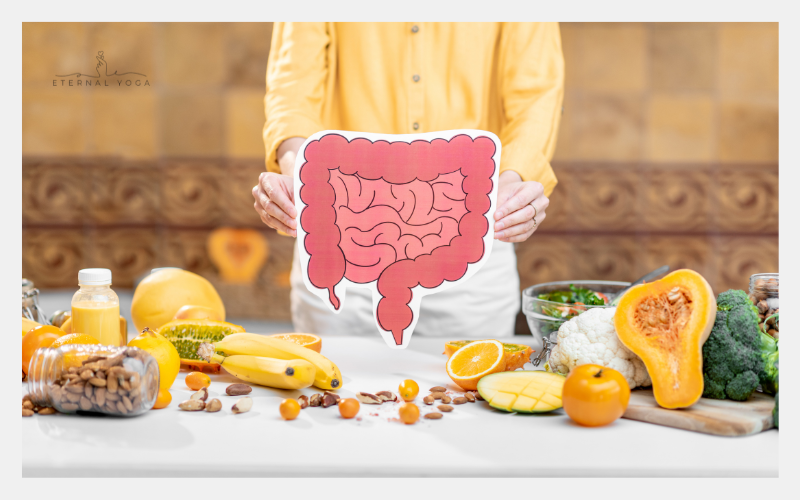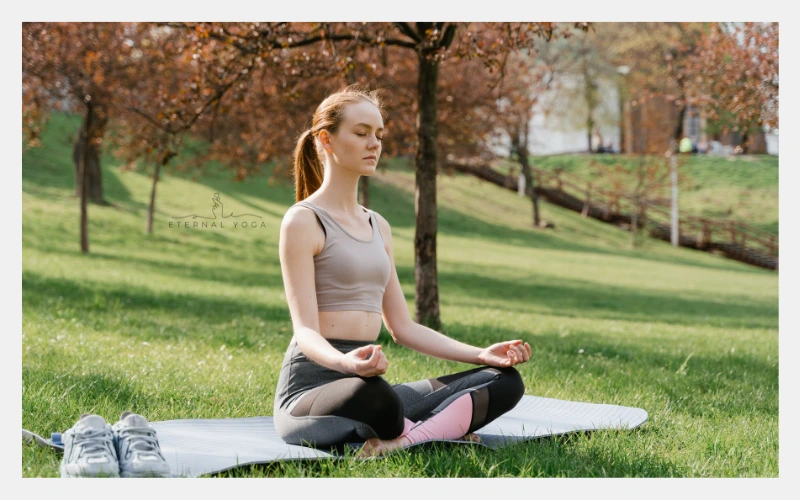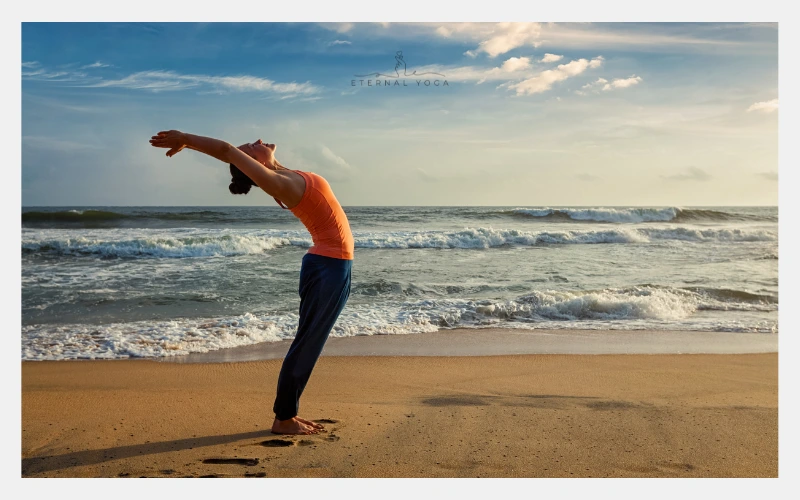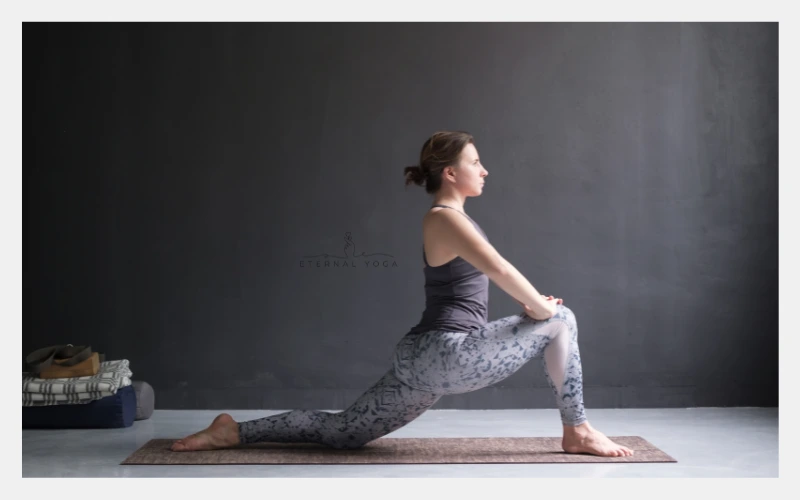Through conscious breathing, gentle stretches, and focused movements, yoga activates your parasympathetic nervous system (“rest and digest” mode), lowers stress hormones, and creates a safe mental state where anxiety has less room to thrive.
At Eternal Yoga, I draw on years of dedicated practice, research, and experience guiding others on their health journey. My approach blends traditional yoga wisdom with modern science to create routines that are not only effective but also friendly to both beginners and experienced practitioners.
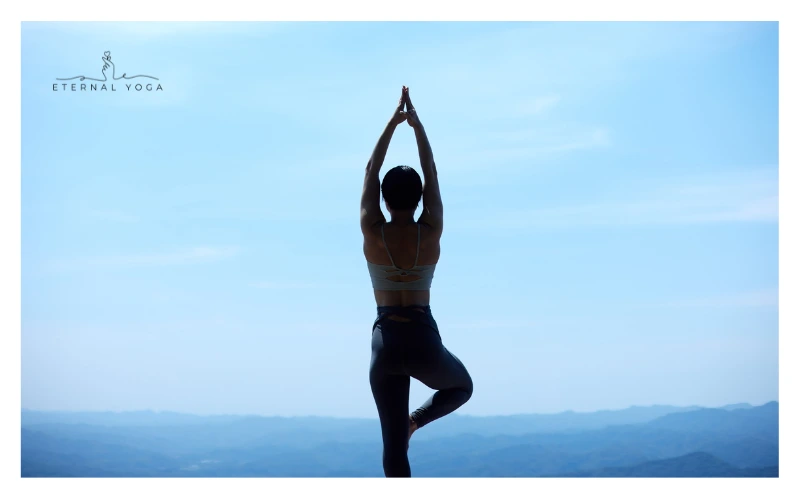
Whether you’ve never stepped onto a yoga mat or you’ve been practicing for years, you’ll find that yoga for anxiety is less about the perfect poses and more about finding a path to peace.
Introduction
Anxiety can feel like a storm you can’t control, with racing thoughts, a pounding heartbeat, and a constant feeling of uneasiness. You can try to distract yourself, work through the day with energy, or hope the feeling goes away, but the storm often returns. What if, instead of fighting it, you could gently lead it into calmer waters?
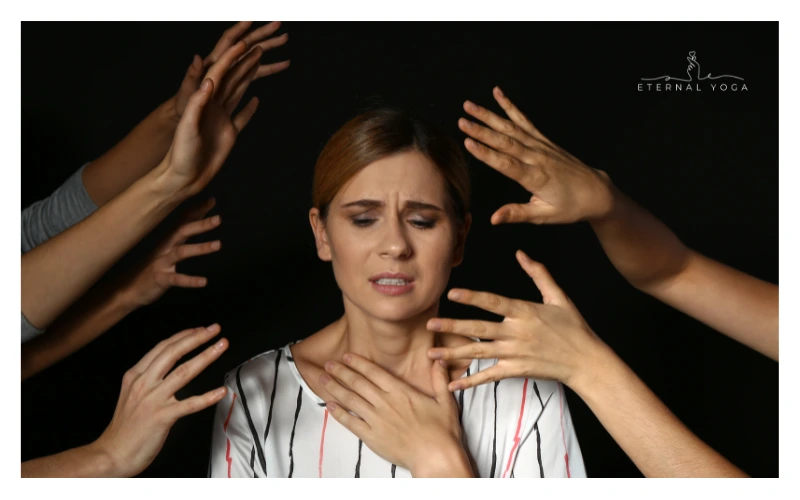
This is where Yoga for Anxiety comes in. More than just stretching or exercise, yoga is a holistic mind-body practice that teaches you to breathe amid the chaos, ground yourself in the present, and quiet the noise inside.
“After just two weeks of practicing these poses every evening, I noticed my racing thoughts were slowing down. I’m finally sleeping through the night again.” – Sarah, 34
Combining mindful movement with deep breathing and meditation helps you not only manage anxiety in the moment but also build long-term resilience against it.
In this guide, we’ll explore the most effective yoga postures, breathing techniques, and mindfulness tips that can help you feel clearer, calmer, and more in control starting today.
How Anxiety Affects the Mind & Body
Anxiety isn’t just feeling “nervous”; it’s a whole-body experience that can affect your physical health, emotional balance, and even your ability to make daily decisions. When you’re anxious, your brain activates the fight-or-flight response, flooding your body with stress hormones like cortisol and adrenaline.
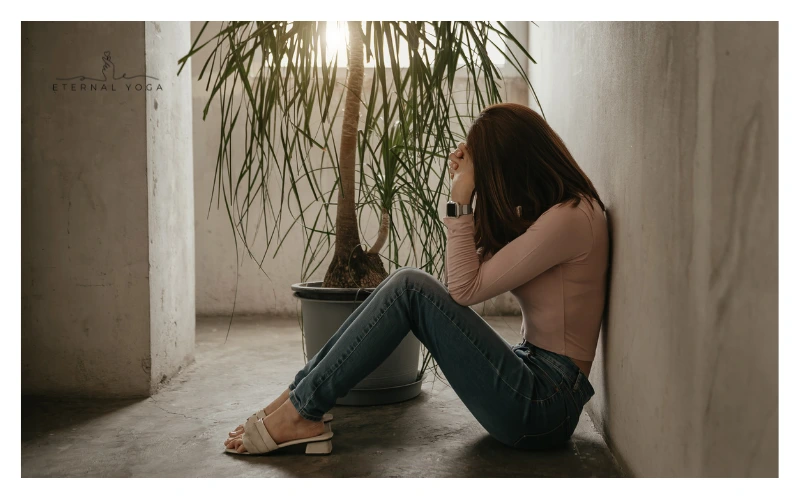
In the short term, this response is helpful; it prepares you to face danger. But when anxiety persists for weeks or months, it can start to cause harm:
- Mind: Racing thoughts, persistent worry, difficulty concentrating, overthinking, and “what if” thoughts.
- Body: muscle tension, headaches, rapid heartbeat, shallow breathing, digestive issues, and sleep disturbances.
- Emotions: irritability, restlessness, and a constant feeling of being “on edge.”
“Yoga became my safe space. Whenever I feel that tightness in my chest, I turn to the breathing and stretches, and within minutes, I feel lighter.” – Daniel, 42
Constant anxiety can make you feel isolated from yourself and your surroundings. Over time, this constant state of alertness can affect your mood stability, weaken your immune system, and drain your energy, making it difficult to enjoy daily life.
This is where yoga offers a unique advantage. Unlike quick relaxation techniques that only provide temporary relief, yoga addresses anxiety from multiple aspects, improving breathing control, calming the nervous system, and restoring balance between mind and body.
How Yoga Helps with Anxiety
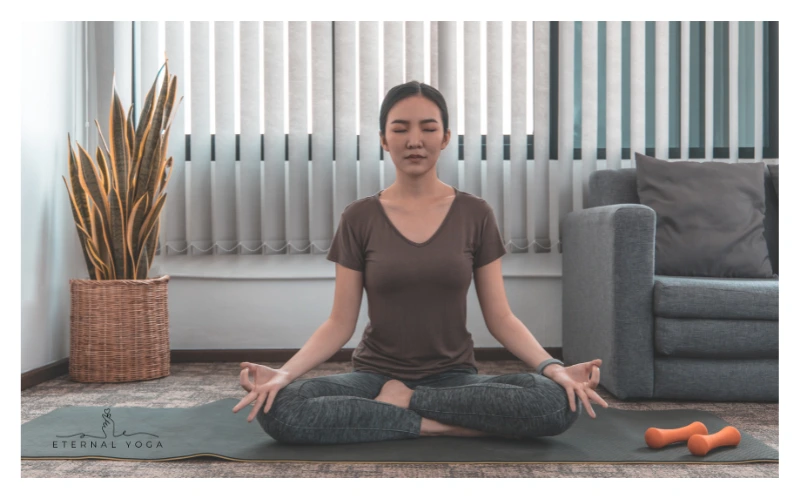
Yoga is more than just physical activity; it is a holistic practice that nurtures your mind, body, and breath. It is particularly effective in relieving anxiety because it tackles both the physical symptoms and the mental triggers.
“I never thought something so gentle could make such a difference. My anxiety attacks are less frequent, and I feel more in control of my life.” – Maya, 28
Here’s how Yoga for Anxiety works to calm anxiety:
- Activates the Relaxation Response
Gentle stretches, deep breathing, and mindful postures stimulate the parasympathetic nervous system, your body’s “rest and digest” mode, which naturally lowers stress hormone levels, heart rate, and blood pressure. - Improves Breath Awareness
Anxiety often causes shallow, rapid breathing, which tells the brain to stay on high alert. Yoga teaches pranayama (breath control) techniques that slow and deepen your breathing, signaling safety and calm to your nervous system. - Release Muscle Tension
Stress often settles into the neck, shoulders, and jaw. Yoga postures gently stretch and release these areas, breaking the cycle of tension and discomfort. - Brings You Into the Present Moment
Through mindfulness, yoga shifts your focus from anxious “what ifs” to the “here and now,” helping you stay grounded and aware. - Balances Brain Chemistry
Research indicates that regular yoga practice can increase GABA (gamma-aminobutyric acid), a neurotransmitter associated with reduced anxiety and improved mood.
With consistent practice, yoga can help you not only cope with anxiety when it arises but also develop a resilient, calmer baseline for everyday life.
Read More: 5 Yoga for Mental Health
Yoga for Anxiety: 6 Best Poses
These gentle postures are suitable for beginners, focusing on relaxing your body, slowing your breath, and calming your mind. You can practice them in the morning to start your day with clarity or in the evening to unwind from the day’s stress.
1. Easy Pose with Forward Bend (Sukhasana Variation)
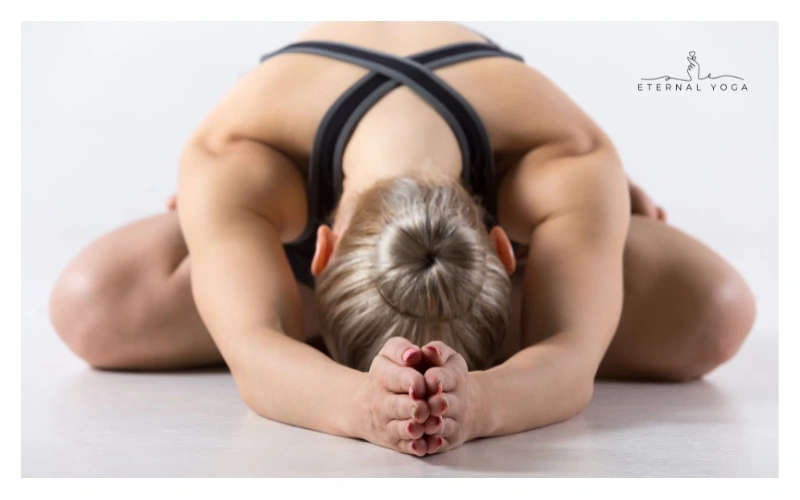
Why it helps: This variation grounds you while gently stretching the lower back, encouraging a sense of safety and stillness.
How to do it:
- Sit cross-legged on the floor or a cushion.
- Inhale deeply, lengthening your spine.
- Exhale slowly as you fold forward, letting your arms extend in front of you.
- Rest your forehead on a pillow, block, or your hands.
- Breathe slowly for 8–10 deep cycles.
2. Seated Forward Bend (Paschimottanasana)
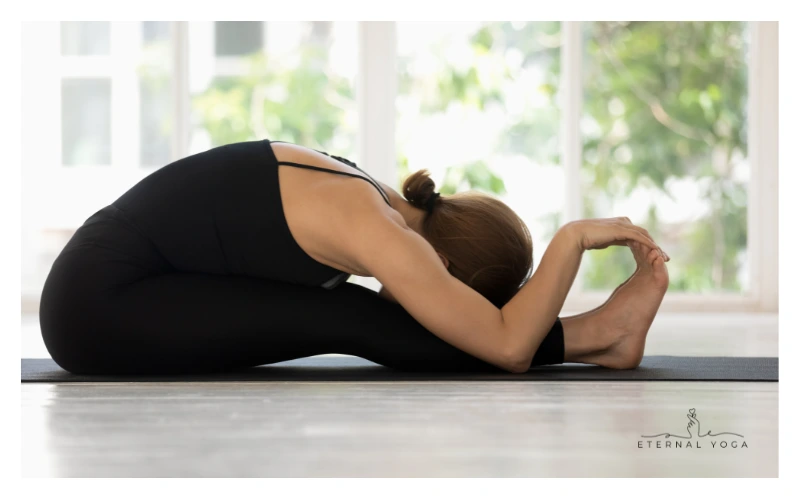
Why it helps: Calms an overactive mind and relaxes the entire back body while encouraging inward focus.
How to do it:
- Sit with your legs extended straight in front of you.
- Inhale to lengthen your spine.
- Exhale, bending forward from your hips rather than rounding your back.
- Keep your knees slightly bent if your hamstrings feel tight.
- Rest your hands wherever they naturally reach and breathe deeply for 1–2 minutes.
3. Reclining Bound Angle Pose (Supta Baddha Konasana)
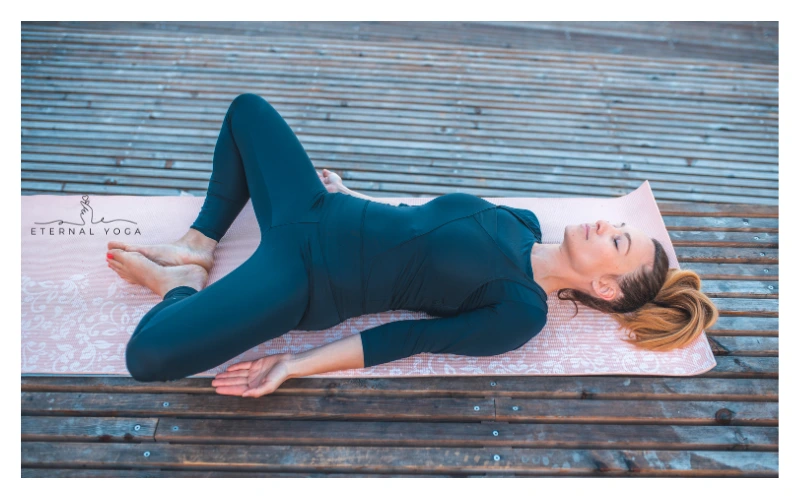
Why it helps: Opens the hips (a common area for storing emotional tension) and promotes deep relaxation.
How to do it:
- Lie on your back with your knees bent and feet together.
- Let your knees fall open, soles of the feet touching.
- Place cushions or yoga blocks under your knees for support.
- Rest your arms by your sides, palms up.
- Close your eyes and take slow breaths for 3–5 minutes.
4. Standing Forward Fold (Uttanasana)
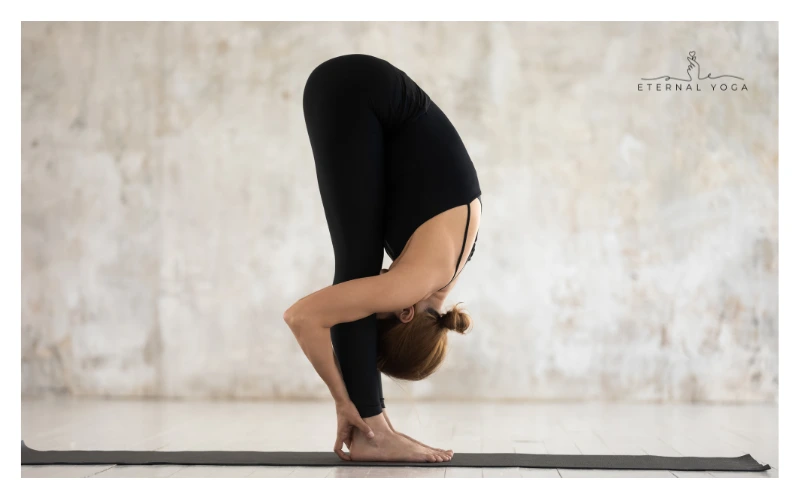
Why it helps: Relieves tension in the spine, neck, and shoulders while increasing blood flow to the brain for mental clarity.
How to do it:
- Stand with feet hip-width apart.
- Inhale, lifting your arms overhead.
- Exhale, hinging at your hips to fold forward.
- Let your head and arms hang heavy.
- Hold for 30–60 seconds, breathing deeply, then slowly roll up.
5. Supported Child’s Pose Twist (Props Version)
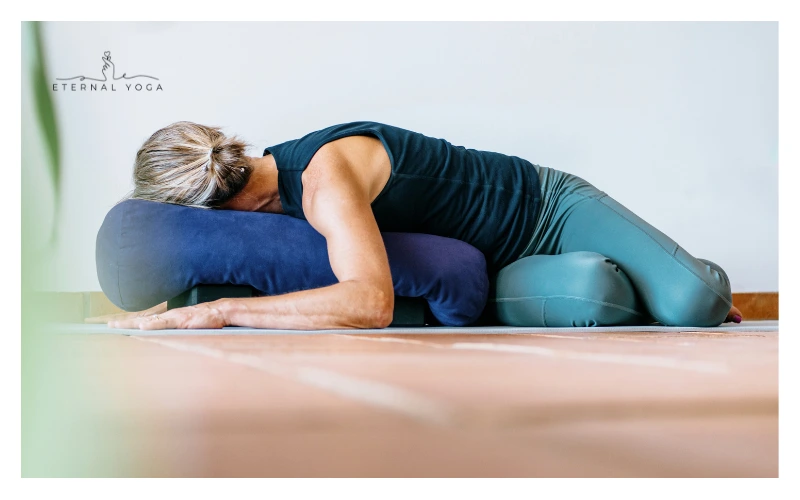
Why it helps: Combines the comfort of a supported position with the calming effects of a gentle twist for the spine.
How to do it:
- Kneel on the floor with a pillow or bolster placed lengthwise in front of you.
- Sit back on your heels and fold forward over the pillow, turning your head to one side.
- Rest your arms comfortably along the sides of the pillow.
- Stay for 1–2 minutes, then turn your head to the opposite side.
6. Reclined Hero Pose (Supta Virasana)
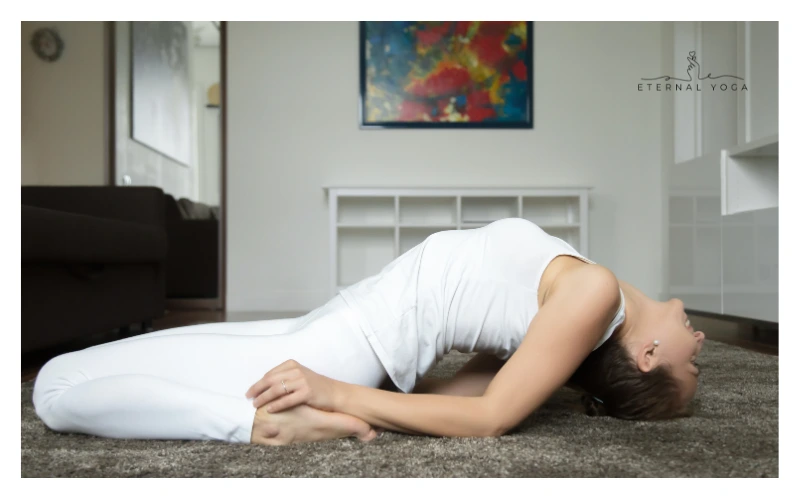
Why it helps: Opens the chest and abdomen, allowing deeper breaths that soothe anxiety and restore balance.
How to do it:
- Kneel on the floor, keeping your knees together and feet slightly apart.
- Sit between your heels (use a cushion if needed for comfort).
- Slowly lean back, supporting yourself with your hands, elbows, and then your back on the floor (or on a bolster).
- Rest for 30–60 seconds, breathing deeply.
Download: 7 Days Yoga Plan for Beginners
Additional Mindfulness Practices to Support Your Yoga Routine
Although yoga itself is a powerful tool for calming anxiety, combining it with other simple mindfulness exercises can produce even deeper results. You don’t need hours of free time; just a few minutes a day can make a noticeable difference.
1. Guided Breathing (Pranayama)
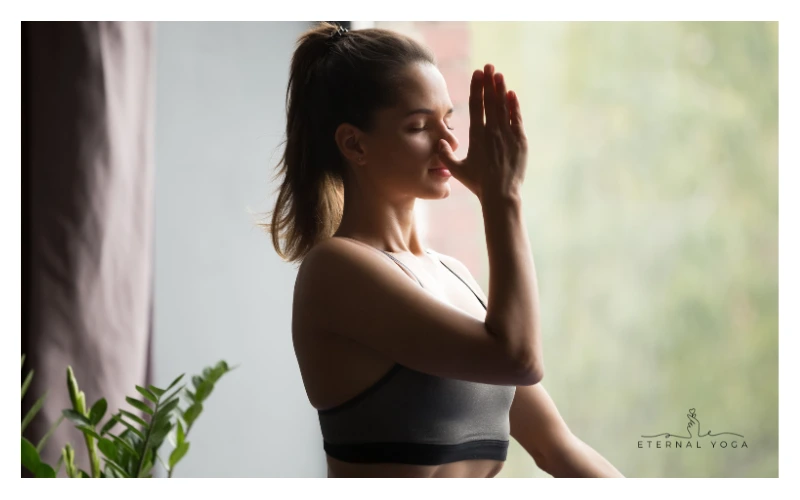
Spending even two minutes on slow, intentional breathing can signal your body to relax. Try the 4-7-8 technique:
- Inhale through your nose for 4 seconds.
- Hold your breath for 7 seconds.
- Exhale through your mouth for 8 seconds.
Repeat for 4–5 cycles.
2. Body Scan Meditation
Lie down or sit comfortably, close your eyes, and mentally trace your body from head to toe. Notice any areas of tension and consciously release them. This can be especially helpful for calming the mind before bed.
3. Gratitude Journaling
Worry often makes us focus on what could go wrong. Writing down three things you are grateful for each day can shift your thoughts toward positivity and peace.
4. Digital Detox Breaks
Constant notifications keep your nervous system on edge. Set aside device-free pockets of time during the day; even 15 minutes can help reset your mind.
5. Nature Connection
Spending time outdoors, whether it’s a short walk in the park or simply sitting under a tree, can significantly reduce stress hormone levels and improve mood.
6. Aromatherapy
Using calming scents like sandalwood, lavender, or chamomile while doing yoga or meditating can help deepen your sense of relaxation.
With a consistent yoga practice and these mindfulness habits, you’ll train your mind and body to handle stress more easily, making anxiety less dominant in your daily life
Conclusion: Your Path to Calm Starts Today
Anxiety can feel like a constant shadow, but it doesn’t have to define you. By taking time for yourself, even for just a few minutes a day, you can feel grounded and calm from stress and discomfort.
You don’t have to be flexible, strong, or experienced to get started. All you need is a quiet space, a little time, and a willingness to breathe during each pose.
At Eternal Yoga, my mission is to lead you to a healthier, more balanced life, one breath, one pose, one day at a time. So roll out your mat, take a deep breath, and start your journey to a calmer, happier you today.
Frequently Asked Questions
Can yoga help with anxiety?
Yes. Many studies have shown that yoga can reduce stress hormones, improve mood, and activate the body’s relaxation response.
How often should I practice yoga for anxiety relief?
Even 10–20 minutes a day can make a difference. The key is consistency. You don’t need to spend hours on the mat; short, mindful sessions are often more effective than occasional long ones.
Do I need to be flexible to start yoga?
Not at all. Yoga is about progress, not perfection. You can modify every pose to suit your current fitness level, and flexibility will naturally improve over time.
How long will it take to see results?
Some people notice a calmer mind after their very first session. For lasting changes, most practitioners see significant improvements in 3–6 weeks of regular practice.
Is yoga a replacement for therapy or medication?
No. Yoga is a supportive tool, not a substitute for professional care. If your anxiety is severe, it’s best to combine yoga with guidance from a mental health professional.
What’s the best time of day to do yoga for anxiety?
Many find morning yoga helps set a peaceful tone for the day, while evening sessions are great for unwinding before bed. The “best” time is when you can commit consistently.
Can I do yoga for anxiety at home without a teacher?
Yes. With online resources, guided videos, and clear instructions, you can safely start at home. Just listen to your body and avoid pushing into pain.

